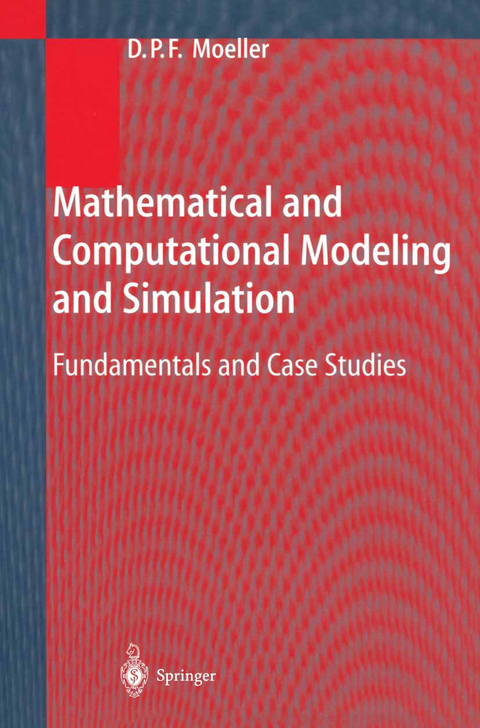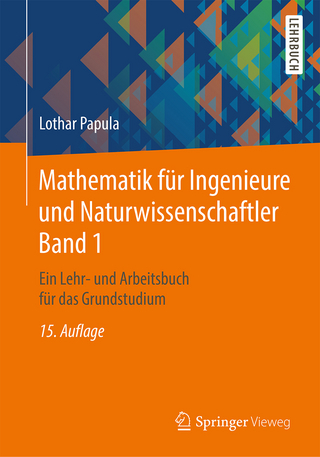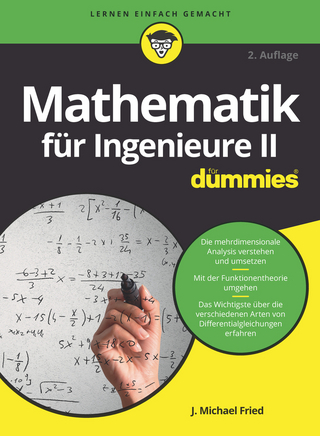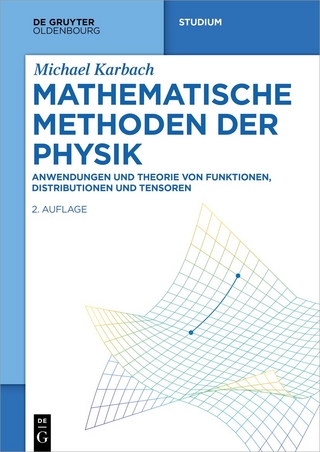
Mathematical and Computational Modeling and Simulation
Springer Berlin (Verlag)
978-3-540-40389-0 (ISBN)
1 Modeling Continuous-Time and Discrete-Time Systems.- 1.1 Introduction.- 1.2 Modeling Formalisms.- 1.3 System Elements and Models of Continuous-Time Systems.- 1.3.1 Electrical Elements.- 1.3.2 Particle Dynamics.- 1.3.3 Mechanical Elements.- 1.3.4 Fluid Mechanics.- 1.3.5 Diffusion Dynamics.- 1.3.6 Thermodynamics.- 1.3.7 Chemical Dynamics.- 1.4 Block Diagram-based Algebraic Representation of Systems.- 1.4.1 Introduction.- 1.42. Block Diagram Algebra.- 1.5 Basic Principles of Discrete-Time Systems.- 1.5.1 Introduction.- 1.5.2 Modeling Concept of Discrete-Time Systems.- 1.5.3 Simulation Concept.- 1.6 Model Validation.- 1.7 References and Further Reading.- 1.8 Exercises.- 2 Mathematical Description of Continuous-Time Systems.- 2.1 Introduction.- 2.1.1 Representation of System Differential Equations in Terms of Vector-Matrix Notation.- 2.1.2 Existence and Uniqueness of Solutions of Differential Equations.- 2.2 Controllability, Observability, and Identifiability.- 2.3 Time Domain Solution of the Linear State Equation System.- 2.4 Solution of the State Equation using the Laplace Transform.- 2.5 Eigenvalues of the Linear Vector-Equation Systems*.- 2.6 Stability Analysis*.- 2.6.1 Routh Hurwitz Criterion*.- 2.6.2 Nyquist Criterion*.- 2.6.3 Ljapunov Stability Theorem*.- 2.7 First-Order Linear State-Equation Models.- 2.8 Second-Order Linear State-Equation Models.- 2.9 Higher-Order Linear State-Space Models*.- 2.10 Nonlinear State-Space Models*.- 2.11 References and Further Reading.- 2.12 Exercises.- 3 Mathematical Description of Discrete-Time Systems.- 3.1 Introduction.- 3.2 Statistical Models in Discrete-Time Systems.- 3.2.1 Random Variables.- 3.2.2 Distributions.- 3.3 Discrete-Event Simulation of Queuing systems.- 3.4 Petri-Nets.- 3.5 Discrete-Event Simulation of Parallel Systems.- 3.5.1 Introduction.- 3.5.2 Basic Tasks.- 3.6 References and Further Reading.- 3.7 Exercises.- 4 Simulation Sofware for Computational Modeling and Simulation.- 4.1 Introduction.- 4.2 Digital Simulation Systems.- 4.3 Simulation Software for Continuous-Time Systems.- 4.3.1 Block Oriented Simulation Software.- 4.3.2 Equation-Oriented Simulation Software.- 4.3.3 General-Purpose Simulation Software.- 4.3.4 Component-Based Simulation Software.- 4.3.5 High-Performance Simulation Software for Technical Computing.- 4.4 Discrete-Time System Simulation Software*.- 4.5 Multi-Domain Simulation Software for Large-Scale Systems*.- 4.6 Simulation Software for Mixed-Mode Circuits*.- 4.7 Combined Simulation Software.- 4.8 Checklist for the Selection of Simulation Software.- 4.9 References and Further Reading.- 4.10 Exercises.- 4.11 Case Study Examples.- 4.11.1 FEMLAB.- 4.11.2 ModelMaKer.- 5 Parameter Identification of Dynamic Systems.- 5.1 Introduction.- 5.2 Mathematical Notation of the Identification Task.- 5.3 Identification Task.- 5.4 Output-Error Least Squares Method*.- 5.5 Equation-Error Least Squares Method*.- 5.6 Consistency of the Parameter Estimates*.- 5.7 Consistency Modifications of the Equation-Error Method*.- 5.8 Identifiability*.- 5.9 System Input Properties*.- 5.10 Parameter Identification of the Cardiovascular System*.- 5.11 Error-Functional Minimization by Gradient Methods*.- 5.12 Error-Functional Minimization by Direct Search Methods*.- 5.13 Identifiability and the Output-Error Least Squares Method*.- 5.14 References and Further Reading.- 5.15 Exercises.- 6 Soft-Computing Methods.- 6.1 Introduction.- 6.2 Fuzzy Logic.- 6.2.1 Pure Fuzzy-Logic Systems.- 6.2.2 Takagi and Sugeno fuzzy logic systems.- 6.2.3 Fuzzy-Logic Systems with Fuzzification and Defuzzification.- 6.2.4 Fuzzy Modeling of a Soccer Playing Mobile Robot.- 6.2.5 Fuzzy Modeling of a Wastewater Treatment Plant*.- 6.2.6 Fuzzy-Logic Control System*.- 6.3 Neural Nets*.- 6.4 References and Further Reading.- 6.5 Exercises.- 7 Distributed Simulation.- 7.1 Introduction.- 7.2 Distributed Simulation of Traffic and Transportation.- 7.2.1 Introduction.- 7.2.2 Traffic-Simulation Model.- 7.2.3 Distributed Traffic-Simulation System.- 7.2.4 Description and Implementation of Road Networks.- 7.2.5 Implementation and Simulation.- 7.2.6 Distributed Transportation.- 7.3 Introduction into HLA*.- 7.3.1 HLA at the Very First*.- 7.3.2 Federation Rules*.- 7.3.3 Interface Specification*.- 7.3.4 Object Model Template (OMT)*.- 7.3.5 Suggested Steps at the Very First*.- 7.3.6 Land-based Transportation*.- 7.3.7 HLA Land-based Transportation Simulator*.- 7.3.8 HLA Description of Road Networks*.- 7.4 References and Further Reading.- 7.5 Exercises.- 8 Virtual Reality.- 8.1 Introduction.- 8.2 Virtual Reality applied to Medicine.- 8.2.1 Introduction.- 8.2.2 Morphing.- 8.2.3 Deformable Models*.- 8.2.4 Deformable Models for Surface Reconstruction in Medicine*.- 8.3 Virtual Reality in Geo Science*.- 8.3.1 Introduction*.- 8.3.2 Modeling and Simulation of Space and Time*.- 8.3.3 Combined Virtual Reality System CoRe*.- 8.4 DDSim Prototyping Tool for Autonomous Robots.- 8.5 References and Further Reading.- 8.6 Exercises.- Appendix A.- Numeric Integration.- Single-Step Formulae.- Multi-Step Formulae.- Appendix B.- Laplace Transform.- Appendix C.- Online Resources.
| Erscheint lt. Verlag | 19.8.2003 |
|---|---|
| Zusatzinfo | XV, 422 p. |
| Verlagsort | Berlin |
| Sprache | englisch |
| Maße | 155 x 235 mm |
| Gewicht | 658 g |
| Themenwelt | Mathematik / Informatik ► Mathematik ► Angewandte Mathematik |
| Technik ► Elektrotechnik / Energietechnik | |
| Schlagworte | ACSL • Algebra • AnyLogic • B2Spice A/D • Computational Science • Computersimulation • Continous-time systems • CSM • CSMP • Discrete-time systems • Dynamical Systems • FEMLAB • GPSS • Identification • Ill-defined Problem • ill-posed problem • Mathematical Modeling • MATLAB • Modelica • Modelmaker • numerical simulation • PASION • SIDAS • SIMAN V • SIMSCRIPT • SIMULINK • SLX • Soft Computing • Statistica • Steuerungstechnik • Virtual Reality |
| ISBN-10 | 3-540-40389-2 / 3540403892 |
| ISBN-13 | 978-3-540-40389-0 / 9783540403890 |
| Zustand | Neuware |
| Haben Sie eine Frage zum Produkt? |
aus dem Bereich


